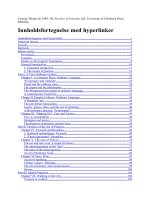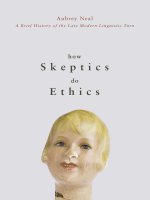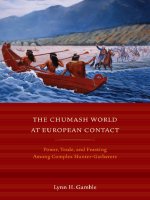university of texas press negotiating for the past archaeology nationalism and diplomacy in the middle east 1919-1941 jul 2007
Bạn đang xem bản rút gọn của tài liệu. Xem và tải ngay bản đầy đủ của tài liệu tại đây (5.19 MB, 308 trang )
NEGOTIATING FOR THE PAST
THIS PAGE INTENTIONALLY LEFT BLANK
Archaeology,
Nationalism,
and Diplomacy
in the Middle East,
1919–1941
NEGOTIATING
FOR THE PAST
JamesF.Goode
University of Texas Press
Austin
Copyright © 2007 by the University of Texas Press
Allrightsreserved
Printed in the United States of America
First edition, 2007
Requests for permission to reproduce material from this work
should be sent to:
Permissions
University of Texas Press
P.O. Box 7819
Austin, TX 78713-7819
www.utexas.edu/utpress/about/bpermission.html
The paper used in this book meets the minimum
requirements of ansi/niso z39.48–1992 (r1997) (Permanence of
Paper).
Library of Congress Cataloging-in-Publication Data
Goode, James F., 1944–
Negotiating for the past : archaeology, nationalism, and diplomacy in
the Middle East, 1919–1941 / James F. Goode. — 1st ed.
p. cm.
Includes bibliographical references and index.
isbn-13: 978-0-292-71497-7 (cloth : alk. paper)
isbn-10: 0-292-71497-1 (alk. paper)
isbn-13: 978-0-292-71498-4 (pbk. : alk. paper)
isbn-10: 0-292-71498-x (alk. paper)
1. Middle East—Antiquities. 2. Archaeology—Middle East.
3. Archaeological thefts—Middle East. 4. Nationalism—Middle
East. I. Title.
ds56.g55 2007
939'.4—dc22 2006037510
To our Arab, Persian, and Turkish friends, for many kindnesses
THIS PAGE INTENTIONALLY LEFT BLANK
CONTENTS
Preface ix
Introduction 1
1. End of the Old Order 19
2. The Sardis Affair 31
3. Heirs of the Hittites 43
4. Egypt Awakening 67
5. Housing Egypt’s Treasures 99
6. France’s Closed Door 127
7. Winning Persepolis 141
8. Troubles over Iran 167
9. Archaeology as Usual 185
10. The Reign of Sati al-Husri 203
11. A New Era 223
12. Reflections 229
viii Negotiating for the Past
Notes 235
Bibliography 267
Index 281
PREFACE
My introduction to this subject was serendipitous. While doing research
in U.S. State Department records at the National Archives, I repeatedly
came across references to Persepolis and an ongoing crisis in U.S Iranian
relations during the 1930s, which aroused my curiosity. As a Peace Corps
volunteer in Iran, I had visited Persepolis in 1969 and again in 1971, but I
had never connected it in any way to foreign affairs. I decided to investi-
gate once the current research was completed.
That was welloveradecadeago,andIhavebeenengagedon this project
ever since. I quickly discovered a triad of actorsinvolved in thatand other,
similar regional crises. There were U.S. diplomats supporting American
archaeologists,who encountered increasing challenges from local nation-
alists.Thesethree groups haveprovidedthe subtitle and, more important,
the substance of this study.
Originally, I intendedto focuson Iran,but gradually the project spread
beyond its borders to include Turkey, Egypt, and Iraq, for the more I re-
searched,the more clearly I could see similarities and links between devel-
opments in these four countries. My career path led me to three of these
nations, first the long residence in Iran, then a yearlong Fulbright grant in
Turkey, and finally numerous visits to Egypt as director of study-abroad
programs.This has afforded opportunities tovisit archives, museums, and
sites and to interview several archaeologists. Upon reflection, I suppose
the broad scopeof this study was almost predestined, for I have always had
a keen interest in the various peoples of the Middle East, especially the
Arabs, Persians, and Turks, and an appreciation for the many parallels in
their histories.
Other works have taken up the subject of the intersection of archae-
ology and nationalism, but they have done this almost exclusively within
the borders of a single nation. Of this genre, Donald Reid’s fine study on
Egypt, Whose Pharaohs? (2002), and more recently Magnus Bernhards-
son’s Reclaiming a Plundered Past (2006) on Iraq come readily to mind.
x Negotiating for the Past
There are good, practical reasons to narrow one’s focus, especially when
a scholar considers the multiplicity of languages and historical traditions
across the region.
And yet my own broad interests and the many indications from the
sources that these nations had experienced remarkably similar develop-
mentsintheinterwarperiodconvincedmetoproceed.Herewasasubject,
it appeared, that would invite comparison and an emphasis on connect-
edness, that would allow me to focus on similarities across the region. No
single author, of course, can know each of these four nations as well as
many scholars will know any one of them, and I have relied heavilyon the
expertise of others, suitably acknowledged. Even then, it has taken more
years to complete this study than I could have imagined at the outset.
One of the greatest challenges in writing such a work is to give voice
to non-Westerners, especially to local nationalists, who may have left few
written records or whose official accounts are not readily available. To
overcome this, I have relied heavily on the secondary accounts of other
scholars and also on my own translations from Arabic, French, German,
and Persian (and on the assistance of former students for Turkish ma-
terial). These include sections of autobiographies, letters, and, above all,
newspaper and journal accounts. From these I have been able to recon-
struct the arguments of those nationalists who were most centrally in-
volved with archaeological matters.
Iwanttobeclearaboutthefocusofthework.Withineachofthefour
case studies, I am examining interactions among three groups of partici-
pants: archaeologists, nationalists, and diplomats. If the reader will imag-
ine three overlapping circles, representing archaeology, nationalism, and
diplomacy, this studyconcerns especially that limited area wherethe three
intersect. It does notclaim tobe a comprehensive studyof anyoneof these
fieldsbut rather an analysis of how all three intersected, and to what effect,
in each of these nations during the interwar years. Much could bewritten
about each of these fields separately, and much has already been written;
my objective is less grand, and yet even within these limits, the challenge
has been substantial.
The two world wars bracket the study, for together they dramatically
influenced the events discussed here. They disrupted normal patterns,
especially those established by Western archaeologists in the region, and
in so doing hastened processes of change in unimagined and unintended
ways. A comparison of the accounts of two leading archaeologists dating
from the close of each of these conflicts, one by James Breasted written
Preface xi
in 1920, the other by John Wilson written in 1946, provides eloquent tes-
timony of the degree to which Middle Eastern archaeology had changed
during the intervening years and of the extent to which local nationalist
elites had become empowered.
Given the tendency to ascribe overwhelming agency to Western
powers and their institutions in the developing world prior to World
War II, it may surprise some to discover just how successful nationalist
elites could be in exercising control over archaeological affairs in many
parts of the Middle East. This, of course, was a long-term trend; it did
not happen quickly, and sometimes there were setbacks. Yet by the end
of this twenty-year period of negotiation, nationalist elites had achieved
remarkable success in attaining their objectives.
Such a long period of research in an array of archives on four conti-
nents couldnotsucceedwithouttheassistance of archivists,librarians, and
scholars. I will remain always in their debt. I would like to single out two
individuals who assisted this project over long periods and in especially
significant ways. Alessandro Pezzati, reference archivist at the University
Museum of the University of Pennsylvania, assisted me on three sepa-
rate occasions during lengthy stays in Philadelphia, guiding me expertly
throughthevoluminous sources. JohnLarson, archivist attheOrientalIn-
stituteoftheUniversityofChicago, did anexcellentjobofintroducing me
to thesuccessionofrichmaterials at his disposal on each of my many visits,
and all thisat a timewhen the archivewas undergoing a major transforma-
tion.He has continuedto assist as issues and questions have arisenover the
intervening years. Several of my graduate students at Bilkent University,
Ankara, especially Mehmet Ergin, Sibel Ertürk, and Fatih Tokatli, helped
to translate relevant Turkish materials. Dr. Reza Nezar-Ahari of the Cen-
ter for Documentsand Diplomatic History,Tehran, provided useful pub-
lished materials from his archive. Interlibrary loan staff at Grand Valley
State University have for many years now assiduously tracked down elu-
sive sources at my request. I am grateful to Wendy Moore at the Univer-
sity of Texas Press for her patience and efficiency in bringing this book
to publication. Finally, I extend my thanks to a small group of scholars
who have taken time to discuss this project with me or have read and
commented on parts of the manuscript. These include Majd al-Mallah,
Magnus Bernhardsson, Toni M. Cross, Elizabeth Fernea, Bert DeVries,
Robert H. Ferrell, Charles Gates, Douglas Little, Ilknur Özgen, Donald
Reid, Neil Asher Silberman, Reeva Simon, El-Mubarak Yahya, and the
anonymous readers chosen by the Universityof Texas Press. My colleague
xii Negotiating for the Past
Roy Cole kindly produced the maps for the book. For financial support
of my research I would like to thank the Rockefeller Archive Center, the
American Institute for Persian Studies, the Fulbright Commission, and,
most important, the Research and Development Committee and the Pad-
nos International Center at Grand Valley State University.
NEGOTIATING FOR THE PAST
THIS PAGE INTENTIONALLY LEFT BLANK
INTRODUCTION
This study of the Middle East during the two decades after World War I
examines events in the region from the perspective of archaeology. This
twenty-year period witnessed a major transformation in Middle Eastern
archaeology, and such an approach provides a key to understanding many
of the important political, cultural, and diplomatic developments during
those critical years. The detailed discussion and analysis of archaeological
affairs in Turkey, Egypt, Iran, and Iraq, which shared remarkably similar
experiences, reveals how intertwined the field had become with the broad
agendas of the nationalist elites of the day.
ForWesternarchaeologists the interwaryears would prove remarkably
different from what had gone before. Prior to World WarI archaeologists
in the Middle East operated with a minimum of regulation. Even where
a strongly worded antiquities law existed, as in the Ottoman Empire after
1906, local officials rarely enforced it, especially at the distant perimeters
of the realm. This prewar period, then, became the great age of collection
building, when the museums of the West were built and filled with won-
derful antiquities from everycorner of theworld. The Middle East, given
its relative ease of access and profusion of ancient sites, contributed more
than its share to public exhibition halls and private collections in Europe
and the United States.
This monograph examines the middle period, what some have called
the years of negotiation, to show how archaeologists, their institutions,
and their governments negotiated with local nationalists and how they
steadily lostground in their struggle to avoidstricter controls.Whowould
excavate, and where and under what conditions? Who would keep the an-
tiquities that were found? Who would write the histories of what was dis-
covered? These questions arose repeatedly over the two decades because
newlyempowered nationalists in Ankara, Baghdad, Cairo, and Tehran re-
fusedtoacceptthestatusquo.
This negotiation produced much tension, for it was a time of challenge
2 Negotiating for the Past
to established practices and, quite naturally, it contributed to crises that
threatened to disrupt peaceable and friendly relations, not only among
those directly concerned, but among their governments as well. There is
arguably no better way to understand the struggle between rising nation-
alist movements in the developing world and Western interests than to
examine the courseof relations in regard toquestions of cultural heritage.
In addition to the four case studies—Turkey, Egypt, Iran, and Iraq
—this book makes brief references to other parts of the region, espe-
cially Palestine and Syria. I have chosen these four countries because they
provided the best examples of well-established and successful nationalist
movements during theseyears. In each case thenationalists came topower
and steadily spread their ideology to a critical part of the population. In
each of these the struggle with foreign archaeologists, who were typically
viewed as representatives of Western imperialism, took clearly defined
paths. These struggles peaked at slightly different times, beginning with
Turkey in the early 1920s, but in each case the nationalists had taken con-
trol over archaeological affairs before the outbreak of World WarII.Even
where foreign archaeologists still served as directors of antiquities, as in
Egypt and Iran, they had little freedom of action and operated under the
watchful eyes of nationalist officials.
Whyfocus on thesefourto theexclusion of otherssuch as Palestineand
Syria? In the latter two mandatesthere were vibrant and complex national
movements, it is true, yet in neither did local nationalist elites succeed in
imposing control over the Europeans in regard to archaeological affairs
as they did in the selected countries. The British high commissioner in
Palestine, for example, was able to negotiate with James Breasted for the
building of a new museum in Jerusalem using Rockefeller money, without
interference from either Palestinians or Zionists. French authorities en-
couraged European and American expeditions to work in Greater Syria,
allowing them to repatriate many of their finds, at a time when such lib-
erality had become a thing of the past in Egypt and Iraq and, of course,
in Turkey as well.
In each of the fourcountries constituting thecore of this study,nation-
alist elites succeeded in establishing control over foreign archaeologists.
Such changes did not come immediately, or without periods of tension
and crisis, but the process seemed almost irresistible. The transformation
happened first in Turkey under Atatürk,wherevirtually no antiquities left
the country legallyafter the early years of the republic. Next came Egypt,
where the Wafd Party under Sad Zaghlul challenged Lord Carnarvon
and Howard Carter’s right to a share of the treasure of Tutankhamun.
Introduction 3
Egypt won that important struggle. The nationalists then pressured the
French directors of antiquities in Cairo, Pierre Lacau (1914–1936) and his
successor, Étienne Drioton (1936–1952), to tighten restrictions generally
over the division of antiquities. By the end of the 1930s, most foreign ex-
peditions had withdrawn from the country. In Iran, too, nationalist au-
thorities exploited divisions among the Westerners to get the French mo-
nopoly over Iranian antiquities canceled. Later they went on to set the
regulations for excavations and to assume control over the nation’s pre-
mier archaeological site, Persepolis. In Iraq, the nationalist Sati al-Husri,
director of antiquities (1934–1941), extended his control over Western
archaeologists, severely restricting the terms under which they could ex-
cavate in the kingdom. Many of them fled across the border into the
French mandate of Syria. In each of these the trend toward greater local
control had become clear well before the outbreak of World War II.
1
Thus the post–World War II era found local national governments ex-
ercising almost complete control over their ancient sites and antiquities.
They determined who would excavate, where and under what conditions.
Often their own archaeologists worked in cooperation with Western col-
leagues, a practice almost unheard of priorto 1945; insome countries for-
eign archaeologists were unwelcome, and ‘‘native’’ archaeologists carried
out excavations on their own. Antiquities laws, too, had changed. Now
export of artifacts was carefully controlled, in many cases forbidden al-
together. MostWestern archaeologistshad come to accept these newcon-
ditions almost without complaint.
These countries did not act in isolation but learned from each other’s
experiences, from their failures as well as their successes. The Turks
looked to Greece and other European countries for their models. The
Egyptiansfollowed closelydevelopmentsin the Republic of Turkey, espe-
cially in matters of cultural heritage. Officials in both Iran and Iraq knew
the details of the struggle that had taken place in Egypt over the tomb
of Tutankhamun, King Tut, and modeled their antiquities laws on those
of Cairo.
Serving to energize the nationalists and to complicate matters for for-
eign archaeologists was the fact that some of the most remarkable ar-
chaeological discoveries came during this period: Tutankhamun in Egypt
(1922), Ur in Iraq (1927), Persepolis in Iran (1932), Daphne in Syria (1936)
(annexed by Turkey, 1939). These served as focal points of controversy,
bringing an immediacy to the debate over the rights of excavators versus
those of host governments. Thus the very success of Western archaeolo-
gists exacerbated tensions with local nationalists.
4 Negotiating for the Past
Although there is much in this study about British and French archae-
ology, and somewhat less on German, which was less active in this period,
American archaeology takescenter stage.There are goodreasons for this.
The interwar period saw a dramatic expansion of the discipline in the
United States, for this was a time when Americans and their institutions,
as in so many other areas of endeavor, including business, communica-
tions, and entertainment, dominated the field as never before. Although
the most prominent American archaeologists had received their advanced
training in Germany, new academic departments were being established
intheUnitedStatestotrainstudentsathome.ThenotedEgyptologist
James Breasted persuaded Americans that archaeology was a necessary
academic discipline for the study of man. Breasted’s importance in this
period is hard to exaggerate. With the strong support of the Rockefellers,
he established archaeological expeditions throughout the region. He will
appear again and again throughout these pages.
2
Americans such as Breasted had expansive plans for the Middle East,
which, theybelieved,held the secretsoftheoriginof Western civilization.
To decipher these, they introduced new, more sophisticated techniques.
They considered themselves scientists, a view that put them in concert
with 1920s advocates of technological and scientific advancements in the
United States. Breasted’s closest friend was George Hale, the well-known
astronomer, and Breasted, who wrote history books for the general public
and servedas president of theAmericanHistoricalAssociation (1928),was
also inducted with much fanfare into the National Academy of Science
in 1920 and the American Association for the Advancement of Science
in 1933.
Most important, the Americans had money, and the Europeans, suf-
fering from the tremendous expense and destruction of World War I, did
not. They were hard pressed to put expeditions in the field and certainly
to supply them as amply as Breasted could. Traditionally, European expe-
ditions had closer ties to their respective governments, receiving much of
their fundingfrom public monies ratherthan from privatephilanthropies.
After 1918 their governments could spare few resources for archaeology,
a situation commonly lamented among European scholars. They envied
the wealthy Americans, who showed them new ways of organizing and
outfitting their expeditions. In these early years there were not enough
trained American archaeologists, however, and so American institutions
hired British, Dutch, and German experts. These became truly interna-
tional undertakings.
Americans were also in the vanguard because they had started much
Introduction 5
later than the Europeans, and they were eager to catch up. European
museums already bulged with exquisite antiquities, which they had been
collecting since the late eighteenth century. After World War I civic-
minded philanthropists in the United States would pay for splendid mu-
seum buildings and for expeditions to fill them. There was a sense of
urgency in all this, for even the most unenlightened archaeologist or mu-
seum director sensed that the day could not be far off when the door tothe
export of antiquities would be closed, perhaps forever. Struggle though
they might against such an eventuality, they wanted to get all they could
while law and practice still treated foreigners generously. Their determi-
nation often brought them into conflict with local authorities attempting
to restrict the flow of antiquities abroad.
As wemight expect, American sources for this period are abundant and
accessible. Archives contain not only letters, reports, diaries, and jour-
nals of Americans but also of many foreign archaeologists, who worked
closely with them, such as the Britishers Leonard Woolley, who excavated
at Ur, and HowardCarter, discoverer of the tomb of Tutankhamun. Euro-
pean and American institutions often organized joint expeditions; such
was the case at Ur in Iraq and Antioch, then in Syria, to cite but two ex-
amples. These became more common after the Stock Market Crash in
1929, when many donors stopped contributing. There is in these sources,
as well, interesting material from prominent Middle Eastern nationalists,
such as Satial-Husri (Iraq), Sad Zaghlul (Egypt), and Halil Ethem (Tur-
key). Although I have drawn substantial material from archives in Brit-
ain, France, Egypt, Iran, and Turkey, that from the United States is the
most extensive, showing connections to all the centers of archaeological
activity.
The discipline of archaeology was relatively new in 1919. If not quite
in its infancy, it certainly had not yet matured. It was a Western inven-
tion, growing out of the Enlightenment, the scientific study of the life
and culture of ancient peoples based on the excavation of artifacts. West-
ern archaeologists rarely incorporated local people into the story of a site,
taking them for granted as foremen, laborers, cooks, and domestics.
3
For their part, members of traditional societies rarelyapproached their
ancient history and monuments as scientists. They recited mythical tales
of glorious ancestors, without the need to tie these to specialized study
of surviving sites or monuments. In Egypt, medieval Muslims wrote with
wonder of the pyramids and other antiquities. In a cave in southern Iran
stood a headless statue of Shapur I, the powerful Sasanian ruler. Local
people believed that Iran’s greatness had come to an end when the statue
6 Negotiating for the Past
Figure I.1. Statue of Shapur I in a cave high on a valley wall at
Bishapur, southern Iran. The broken, seven-meter-high statue was
reassembled during the reign of the last shah. Photo by author.
was broken and that it would return when it was repaired. From pre-
Islamic times beginning with the Sasanian dynasty (226–641 c.e.), Irani-
ans had been moved by the ruins of Persepolis, and in spite of the fact
that they had little specific historical knowledge about its builders, the site
retained a crucial symbolic value, which was handed down over the cen-
turies, reinforcing it ‘‘as a place of spiritual resonance with Iranian tradi-
tions of noble greatness.’’
4
Generally, intense local interest in antiquities came only in response to
a demand for them in the West. Once a market existed, illicit digging fol-
lowed.Westernnationshad experienced this patternaswellinthedaysbe-
fore their citizens had been taught to protect their own cultural heritage.
Many early excavators were no more than adventurers and treasure
Introduction 7
hunters; they worked in the region using the most primitive methods,
therebydestroying much of the historical record. By the early1920s, how-
ever, new, more effective methods of excavation had been developed. The
American archaeologist George Reisner, director of the Harvard–Boston
Museum of Fine Arts expedition at Giza in Egypt, was a leader in em-
ploying these techniques. Having been influenced early in his career by
the great British archaeologist Sir Flinders Petrie, a pioneer in the field,
Reisner carefully documented the context in which an object was discov-
ered, keeping detailed records and taking many photographs. These new
methodsspreadquickly,althoughonecouldfindamixoftheoldandthe
new throughout this period.
Also, there was the perennial question of the propriety of purchasing
antiquities from dealers, who usually obtained them from illicit diggers.
At the start of this period, it was a common practice, indulged in by al-
most all archaeologists and museum directors. Only Reisner and one or
two others consistently criticized this trade. By the end of the interwar
period, many had abandoned the custom, pressed by local governments
but also convinced that such a market encouraged illicit digging. Accord-
ing to one expert source, ‘‘an example of ancient artistry which is brought
to light by ignorant natives in a clandestine dig and is sold to a museum
by an antiquities dealer who cannot know the circumstances of its find-
ing mayretainitsaestheticappeal,butasanhistorical document it is
worthless.’’
5
Archaeologists considered themselves scientists, and their reports and
letters are full of references to the scientific nature of their work. This
claim put them at the leading edge of development in 1920s America,
where scientific and technological advancement seemed to hold endless
promise. Theycalled for the continuing export of antiquities in the inter-
est of furthering scientific study.
Archaeologists belonged to an international fraternity, and although
they sometimes engaged in nasty exchanges with each other, these tended
to be personal disagreements, unrelated to nationality. One should not
forget that they often worked together under trying circumstances,
plagued by heat, dust storms, floods, primitive living conditions, inade-
quate budgets, bureaucratic interference. Overall, there was a remarkable
amount of cooperation and camaraderie. Where they came from seemed
relatively unimportant to most of them. It was not uncommon to have
three or four nationalities represented at a single site. How could it be
otherwise when American institutions depended on Europe to supply
them with experts even into the 1930s? In the mid-1930s, with the rise of
8 Negotiating for the Past
anti-Semitism in Germany, American field directors and their sponsor-
ing institutions provided safe haven in the United States for a number of
German Jewish archaeologists.
James Breasted, director of the Oriental Institute at the University of
Chicago,whichsponsoredbyfarthemostexpeditionsintheregion, intro-
duced a new modelof organization.Whereas the Europeanshired archae-
ologists and other specialists only for the duration of the season, three or
four months at most, Breasted contracted them for the whole year. This
guaranteed that virtually the entire staff would returnyear after year, pro-
viding a continuity that had previously been lacking. In the off-season
they would gather in Chicago to study their finds, to work on publiciz-
ing them, to give lectures, and to prepare for the next season. Breasted
was able to implement this practice because of the generous support of
John D. Rockefeller Jr.
Breasted had few equals when it came to fund-raising to support his
expeditions in the field. He was a wonderful storyteller, a gifted historian,
who was able to link the ancient past with the present in ways that allowed
him to play upon potential contributors’ interest in the Bible. Writing to
Rockefeller in May 1925, for example, to seek financial support for an ex-
pedition in Palestine, the director conjured an irresistible vision of what
this picturesque spot must have meant to an earlier resident:
It is oneof theextraordinary things about Megiddo [Armageddon] that
the boyhood village of Jesus is perched upon the hills looking directly
down upon the Megiddo plain. He must have looked down upon it
everydayofHislifethere.WeshallneverknowhowoftenHisown
visions of future peace and brotherhood may have been clouded by the
contemplation of that great battlefield where the fate of the world em-
pires had been decided for thousands of years by the brutal force of
physical power, which He proposed to displace by the rule of love. It
is the task of those who look back upon His wonderful life to piece
together, without a gap, the marvelous development which culminated
inHisteaching.AndwecannotdothiswithoutMegiddo.
6
Archaeology made front-page news, especially in the 1920s, and Breasted
and his colleagues took full advantage of the fact. Amazing discoveries
grabbed the public’s attention at home. American newspapers were filled
with details of the discovery of ‘‘Tut’s’’ tomb and the supposed curse of
the ancient pharaoh. Those few who could afford the trip booked passage
for Egypt’s Valley of the Kings; the majority feasted on the special photo
sections that appeared in all the popular magazines. This response was
Introduction 9
repeated again and again over the decade, following subsequent discover-
ies. Articulate spokesmen, individuals such as Breasted, Woolley, Arthur
Upham Pope, and William F. Albright, had larger than life personalities,
and they enthralled countless audiences with firsthand stories of adven-
ture and discovery in the Orient. One had to be something of a showman
to attract attention and financial support for future or continuing expedi-
tions, and they did not disappoint. To give one example, when Albright,
foremost authority on biblical archaeology in Palestine, took home leave
in 1927, he was swamped with lecture requests from all over the country.
During the winter of 1926–1927, he gave seventy-two formal lectures and
slide presentations, and this in a sabbatical year. Breasted constantly re-
ferred to his own busy lecturing schedule; he was always in demand.
Archaeologistswerenotfreefrom the prejudices of theirday,ofcourse,
and many carried to the Middle East those notions of racial and religious
superiority that were common baggage in the West.Their writings over-
flowed with disparaging references to the ‘‘natives,’’ whose abilities they
impugned and whom they encountered almost exclusively in their roles as
employersandsupervisors of locallaborers.Theyseemto haverecognized
a hierarchy among the various peoples of the region. In Iraq, for example,
they considered their imported Egyptian supervisors to be far superior to
any workers thelocal environment could produce. In Iran,some preferred
Indians over Iranians; in Turkey, it was Kurds over Turks. Overall their
tales were strikingly similar. ‘‘Natives’’ were incapable of respecting the
ancient sites and monuments; they could not be trusted with antiquities,
nor could they appreciate their artistry, and so on. Even in the rare in-
stancewherethey were allowed to assume responsibilities usually reserved
for Europeans, such as taking photographs or keeping the expedition’s
diary, a paternalistic relationship existed between the foreign expert and
local members of his staff.These attitudes contributed to their difficulties
when they began to encounter ‘‘natives’’ in positions of authority.
The education and training of local students as archaeologists was not
encouraged. Many Westerners thought they were incapable of taking on
such large responsibilities on their own. Then, too, if there were local ar-
chaeologists,they would surelychallenge foreigners for a share of the field
and perhaps come to dominate it.Westerners resisted this possibility well
into the interwar period. Even those who accepted the proposition that
‘‘natives’’ could be, perhaps should be, transformed into archaeologists
wanted to put off the day, believing it should come gradually at some un-
specified time in the future. Thus it was not until very late in this period
that a handful of professionally trained archaeologists began to undertake
10 Negotiating for the Past
excavations in their own homelands. Turkey and Egypt led the way, and
by the late 1930s Iraq and Iran had joined them. Local governments, not
Western institutions, sponsored their education.
Surprisingly, Western archaeologists working in the Middle East did
not generally view their activities as in any way political. Thus John Wil-
son of the Oriental Institute could write in November 1937, concerning
the ongoing Arab Revolt (1936–1939) in Palestine, ‘‘We have everyexpec-
tationthatwemaycontinuewithoutseriousdifficulty [M]ost archae-
ologists feel that they are sufficiently removed from the political scene
so that they may continue work in expectation of quiet.’’ Yet everything
they did, from the sites selected for excavation to the disposition of an-
tiquities, drew attention to their activities and frequently engaged them
in controversy.They seemed largely unprepared to cope with the fact that
field archaeology was a highly political practice.
7
Most archaeologists worked on pre-Islamic sites, ignoring the thirteen
centuries since the appearance of the Prophet Muhammad. They knew
little about theArabworld or Islam, and many believed that nothingorigi-
nal had come out of the Islamic world, that everything of worth there had
derived from earlier civilizations. They searched for the roots of Western
civilization and of the Bible, and thesetheyexpected to find in excavations
at prehistoric sites or in ancient Egypt, Palestine, or Sumer, not in the
Muslim dynasties that ruled from Damascus, Baghdad, or Cairo from the
seventh century. Many Middle Eastern nationalists resented this neglect.
These resentments increased as both new (Turkey, Iraq) and old
(Egypt, Iran) states began to define themselves more clearly. Much has
been written recently on the idea of the nation and the special circum-
stances required to bring such an artificial entity into existence. Benedict
Anderson was one of the first to tell us that nations are imagined commu-
nities with constructed identities. Citizens were made, not born. An im-
portant part of this process involved the creation of a narrative of the na-
tion, which would be told and retold until it became accepted as historical
truth. This narrative, rooted in a definite historical perspective, provided
common myths and memories that contributed to a sense of community
among people within a given territory. This common narrative also justi-
fied claims to particular borders.
In recent years, more studies have been written on nationalism, per-
haps, than on any other Middle Eastern topic. It has become clear from
this large body of work that nationalism is extremely complex and that
it always means different things to different people in different contexts.
Nationalist identities are not exclusive and absolute; individuals often









